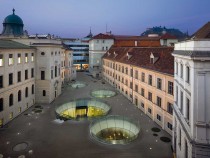
© Roland Halbe
To mark the 200th anniversary of the founding of the Joanneum, a museum that is scattered about various locations, a visitors’ centre was recently opened in Graz. The concept foresaw the creation of a focal point for three existing buildings grouped about a rear courtyard. The new facilities were to include a foyer and auditorium, service areas, a museum shop and a library reading room and depot. The architects did not succumb to the temptation of creating a visually striking new object between the carefully rehabilitated existing structures. Instead, they focused their attention on the intermediate space between them, a gesture that was effective both architecturally and in terms of the urban planning, and which re-sulted in an upgrading of the surroundings. Extending between the older buildings is a homogeneous area, beneath which the new spatial programme was realized. The area is punctuated by inverted, truncated glass cones scattered seemingly at random about the square. These elements are the central feature of the design. The round glass forms projecting from the ground allow a glimpse of the spaces in the basement below. In the largest of the sunken courtyards, two escalators lead to and from the visitors’ centre. The glass cones are also the dominant feature of the underground level with its otherwise restrained design. Between these light wells, one finds fascinating, fluid spatial situations.






